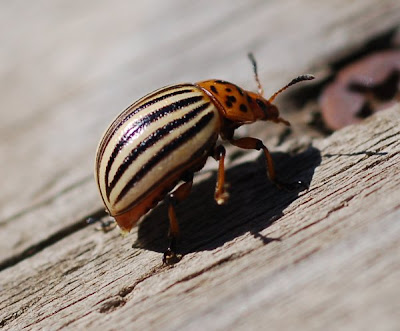
I interrupted these two tater bugs in the act of making more tater bugs on a solenaceous weed (some sort of Physalis, I think) last week. I've found several adults in the yard recently, although our taters are just coming up now. I should be more specific--Colorado Potato Beetles are one of several insects known as "tater bugs," but for me they are the true tater bug type. While they haven't yet attacked our small potatoes, I've picked some adults and eggs off our Hillbilly tomatoes, a variety described as a "potato-leaf tomato." They haven't bothered the other tomato varieties, leading me to believe that tater bugs read the fine print on seed packets.

When I was a kid, my parents subscribed to the opinion offered by the University of Kentucky College of Agriculture "Colorado Potato Beetle Management" fact sheet:
Other non-chemical control measures such as hand picking of adult beetles and immature stages is encouraged as this will aid to delay the development of resistance. Hand picking can be particularly effective in reducing the numbers of overwintering beetles coming to the young plants in the spring.As a small child with nothing better (by adult standards) to do, I spent quality time in the garden, picking these chunky chrysomelid beetles off potato plants and dropping them in a can with some kerosene in the bottom. (Soapy water works well, too, and is probably better for the younger set.) That's the origin of my fascination. The dark spots on the pronotum (that's the brown band behind the head) are variable from individual to individual, and some of them look like letters. I used to study the tater bugs, trying to spell out the message encoded in their heiroglyphs.
In the side view, you can see why the old-fashioned, arch-back mandolins are called "tater bugs" in these parts.

4 comments:
do any birds eat these bugs?
i grew up in (and still live in) a city-and while i have lived in houses with yards (once owned a whole 1/16th of an acre!) i never really got into vegetable gardening.
but my dad, did-after he moved out of the city. he used to hand pick the bugs and put them onto a pie plate (the disposable kind) and set the plate (when full) out for the birds.(he'd crush or decapitate with his finger nail to keep them on the pie plate if they could fly)
very quickly the blue jays learned to land on the pie plate while my father was still collecting bugs and steal the juicy ones before the other birds could get to them.
by the end of the season, dad would just put bugs into his open hand, and the jays would alight on his fingers and gobble out of his palm!
me? i encouraged praying mantis and other helpful bugs..and shared my berrys (raspberries, blackberries, blueberries, currents, and gooseberries) with the birds. (berry are better than veggies, they come back every year with out replanting!-perfect for not so much into gardening gardener!)
How wonderful, to make friends with bluejays while protecting the garden! The Colorado Potato Beetle, in addition to its other endearing qualities, is inedible to most birds and insect-eating mammals. Between having caustic haemolymph and being very hard to crunch, nobody wants to eat them.
A neighbor told me that guinea fowl will eat tater bugs and also Japanese beetles. I was skeptical, but acquired a couple of guineas. There are no bugs on my three rows of potatos this year. I have not seen even one. And as a bonus, guineas do not mess all over the place, or scratch up your yard and flowers. Downside, they are very noisy.
Another reason to love guineas--I didn't think anything could eat tater bugs!
Post a Comment